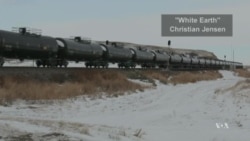In one scene of the Oscar-nominated documentary "White Earth," ice crystals cover the prairie grass and twinkle in the sunlight. Director Christian Jensen said this scene is a quiet reminder of what is being lost.
The film centers on White Earth, a town in the northern state of North Dakota. White Earth sits on a massive oil deposit. That resource, which extends through a broad swath of the state, has turned North Dakota into the second largest oil producer in the U.S., adding a glut of high-paying jobs but taking its toll on the environment.
"White Earth" opens with a scene of the oil rigs, pumping stations, trucks and trains that run all day, every day in White Earth.
The story of the oil boom is told by four children and an immigrant mother. “I really wanted to get an outside perspective from people who are sort of an afterthought when decisions are made to exploit the oil,” Jensen said. “I was interested in looking at what was happening in North Dakota, but in a way that you wouldn’t hear in the major media already covering events in the state.”
James McClellan, 13, is at the heart of the film. He lives in a tiny trailer with his dad. He can’t enroll in school because he is missing an important custody document.
“I sit at home and try to find something to do,” said James, a a witness to life in this desolate place on the open plains.
White Earth can't keep up with its surging population. It has a makeshift restaurant and a bar, but nothing much for a kid to do. People live in their cars, trucks and ramshackle trailers even in the frigid winter. James wonders why.
“Come on, people,” he said, while walking on a snow-packed road in town. “Why should we just take all the beauty away from the landscape by putting up fires and making it smell horrible? All the guys want is money. But I don’t know what would happen if there were no oilfields. That is the only job that my dad ever worked in.”
The population of White Earth is 500, up from fewer than 100 less than 10 years ago. Among the newcomers is Elena Loaiza, a Mexican-American child whose immigrant family fled economic hardship in California to find jobs in the oilfields. Elena’s mother said, “It’s good work for those willing to make the most of it.” She hopes that her children will never have to uproot their families as she has done.
Oil extraction is also an environmental nightmare, Jensen said. “It feels like an otherworldly, almost an alien invasion or something post-apocalyptic, with the flames coming out of the ground, the light and the darkness,” he said.
About the scene when the ice crystals twinkle in the sunlight, Jensen said, “I want these moments to be periods where the audience can sit back and maybe think about their own relationship with the place that they live or their own relationship with oil, their own relationships with immigrants.”
Leevi Meyer, 11, was born in White Earth. Her family has raised cattle in the area for generations. Now they, too, have oil rigs on their land, which adds to their income. But Leevi also sees a downside.
“I can’t go by myself places that much, because they're getting too many people and they're scary,” she said.
Leevi thinks that when she is a really old lady, the oil rigs on her ranch will be gone — and North Dakota will be back to normal.











